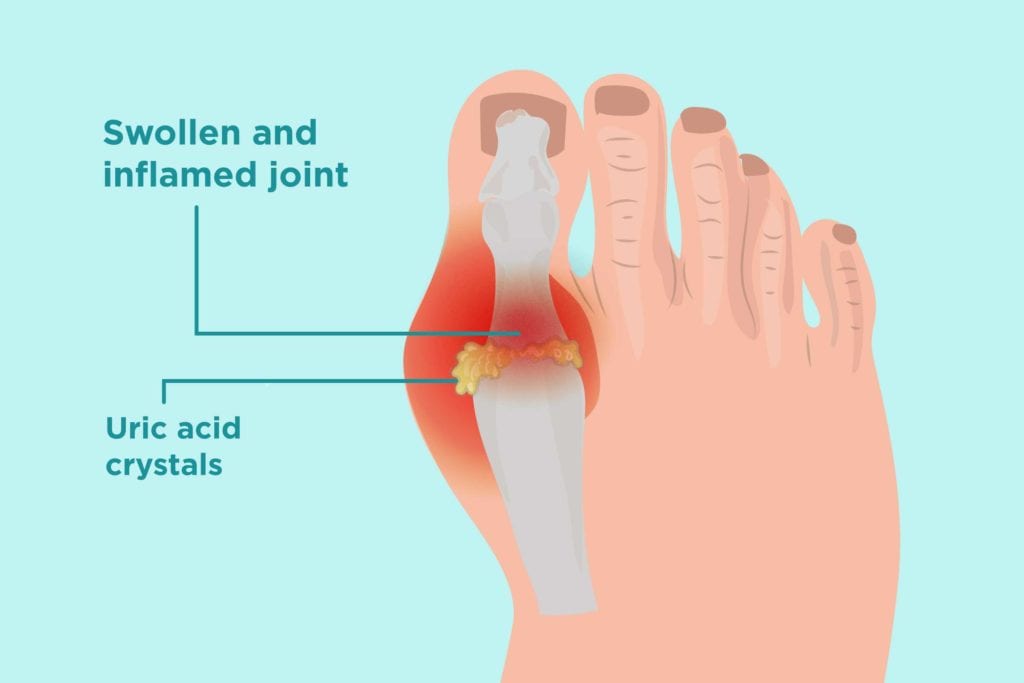When the substances called purine break down it creates a chemical which called Uric Acid. Normally Purines are produced in the body also they can be found in some foods and drinks. Purines contain foods like liver, dried beans, peas, mackerel, anchovies and beer. In this post we are looking what is uric acid and how to deal.
Via blood Uric acid travels to the kidney and passes through urine. If you produce too much quantity of uric acid and it could not remove enough from the body you can get sick. If our body stores high levels of uric acid in the blood it is called hyperuricemia.

Uric Acid Symptoms
- Pain in a joint
- Swelling in a joint
- soreness in a joint
- Joints that are hot when touching
- Red and Purple skin
- Difficult moving
- Misshapen joints
- Kidney Stones
How to Lower Uric Acid
- Loose Weight
- Exercise Regularly
- Manage Stress With Yoga Classes or Meditation
- Practice Restorative Sleep Habits Every Night
- Change to a healthy diet
- Eat plant-based foods
- Stop Smoking
- Vitamin C may lower uric acid
- Balance insulin levels
- Try certain herbal and dietary supplements
Uric Acid Foods to Eat
- Fruits
- Vegetables
- Nuts
- Whole Grains
- Eggs
- Herbs and Spices
- Vegetable Oil
- Potatoes
- Rice and Bread
Uric Acid Foods to Avoid
There are a few foods that are frequently associated with gout flare-ups. The majority of them are classified into three categories: high-purine animal foods, alcohol, and foods rich in added sugars.
Foods to avoid (6, 11Trusted Source, 12, 22Trusted Source) include:
- Liver, kidneys, sweetbreads, and brain are examples of organ meats.
- Boar and venison are two examples of game foods.
- The most prevalent red meats are beef, hog, and lamb.
- Seafood varieties include: Shellfish, oily fish, and tinned fish are all options.
- Sugary drinks: Fruit juices and sugary drinks, in particular.
- Sugary foods include cakes, cookies, candies, and other such products.
- Yeast extracts: These can be found in frozen meals, canned soups, bouillon cubes, and a variety of other foods.
FAQ
What happens when your uric acid is high?
When your uric acid levels surge, it can lead to health conditions such as gout, a form of arthritis causing red, swollen, and intensely painful joints. Elevated uric acid can also result in uric acid crystals forming in the kidneys, leading to kidney stones or even kidney failure in severe cases.
How can I reduce uric acid in my body?
To cut down uric acid in your body, consider a balanced, healthy diet and regular physical activity. Avoid foods high in purines – the substance that transforms into uric acid in your body. This includes red meat, organ meat, and certain types of seafood like mussels and scallops. Remember to stay well hydrated and limit your intake of alcohol, particularly beer, as it may raise uric acid levels.
What foods are high in uric acid?
Foods rich in purines, which the body metabolises into uric acid, include certain meats (such as venison, veal, turkey, and bacon), some types of seafood (like mackerel, anchovies, and herring), and beer. Organ meats, like liver and kidneys, are especially high in purines. Even some vegetables like asparagus, spinach, and mushrooms have moderate purine content.
High uric acid symptoms in females
Women with high uric acid might not always exhibit obvious symptoms until they develop gout, which is less common in females than in males. However, signs can include painful, swollen joints (often starting in the big toe), discomfort in the kidneys (indicating possible stones), and general fatigue.
What level of uric acid is dangerous?
Typically, uric acid levels above 7.0 mg/dL for men and 6.0 mg/dL for women are considered high. Such levels may increase the risk of gout and kidney problems. However, everyone is unique, so consult your doctor for an accurate assessment of your personal risk.
High uric acid symptoms in feet
Elevated uric acid often first manifests as discomfort in the feet. It can result in gout, characterised by sudden, severe attacks of pain, redness, and tenderness, often in the big toe. The affected joint may feel hot and appear swollen. These episodes can last days or weeks.
Low uric acid causes
While less common, low uric acid levels can occur due to certain genetic disorders, exposure to toxins, or as a side effect of drugs such as allopurinol. Conditions like Wilson’s disease, Fanconi Syndrome, and some types of kidney diseases can also cause low uric acid levels. Always consult a healthcare professional if you suspect your uric acid levels are abnormal

